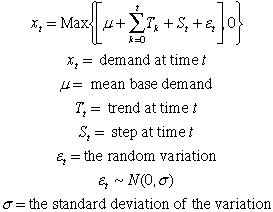|
The mathematical model describing the situation is
shown below. Note that the trend component is accumulated
since the beginning of the simulation with the sum term.
The step component is a quantity added to the base demand
at each iteration.

The trend component is itself a random
variable described in the following.

At each iteration, the trend is the trend
value at the previous iteration plus a new trend added
in the current iteration. The addition is from a Normal
distribution with a specified standard deviation and
a mean of 0. However, whether the current value is added
or not depends on a Bernoulli random variable taking
on the value 0 or 1. The Bernoulli distribution has
the probability parameter given as 0.1 specified on
the dialog.
In practice, this represents a situation
where the series is affected by random influences that
either cause a trend change or not. The probability
of the change is given by the parameter of the Bernoulli
distribution.
The step component is similarly affected
by a random variable with a Bernoulli distribution.
It represents some shock that affects the constant term
added to the base demand. The model for the step component
is similar to the trend component, but it is affected
by different random variables.

Although this model seems complicated,
it might represent a situation where demand is not constant
over time. Such a model could be a useful start for
a variety of situations involving time series.
|



